2015 NISSAN GT-R belt
[x] Cancel search: beltPage 276 of 358
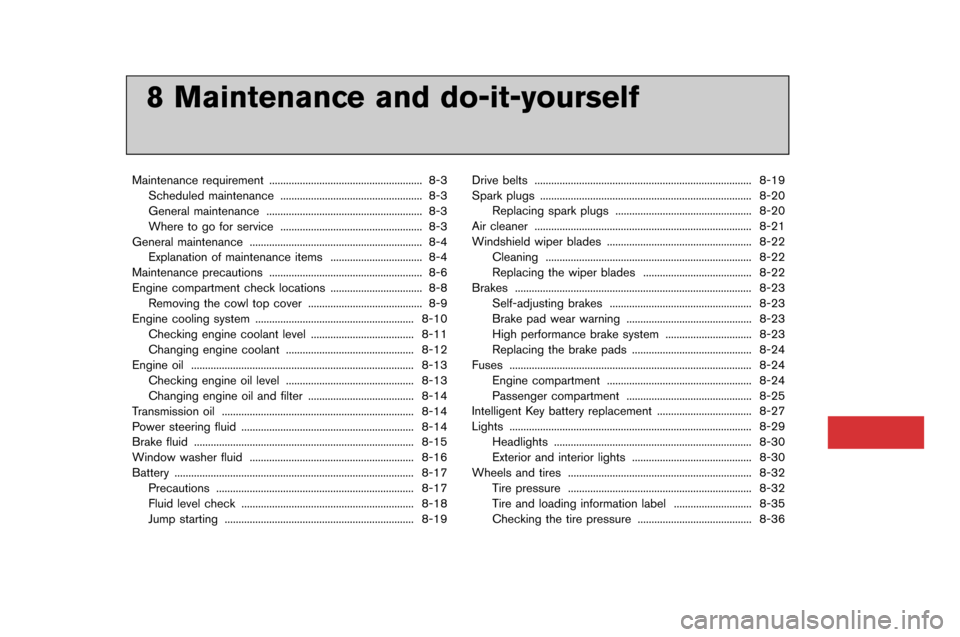
8 Maintenance and do-it-yourself
Maintenance requirement..................�l..................�l..................�l. 8-3
Scheduled maintenance ..................�l..................�l............... 8-3
�feneral maintenance ..................�l..................�l..................�l.. 8-3
Where to go �bor service ..................�l..................�l............... 8-3
�feneral maintenance ..................�l..................�l..................�l........ 8-4 Explanation o�b maintenance items ..................�l............... 8-4
Maintenance precautions ..................�l..................�l..................�l. 8-6
Engine compartment check locations ..................�l............... 8-8 Removing the cowl top cover ..................�l..................�l..... 8-9
Engine cooling system ..................�l..................�l..................�l... 8-10
Checking engine coolant level ..................�l..................�l. 8-11
Changing engine coolant ..................�l..................�l.......... 8-12
Engine oil ..................�l..................�l..................�l..................�l........ 8-13
Checking engine oil level ..................�l..................�l.......... 8-13
Changing engine oil and �bilter ..................�l..................�l.. 8-14
Transmission oil ..................�l..................�l..................�l............... 8-14
Power steering �bluid ..................�l..................�l..................�l........ 8-14
Brake �bluid ..................�l..................�l..................�l..................�l....... 8-15
Window washer �bluid ..................�l..................�l..................�l..... 8-16
Battery ..................�l..................�l..................�l..................�l.............. 8-17
Precautions ..................�l..................�l..................�l................. 8-17
Fluid level check ..................�l..................�l..................�l........ 8-18
Jump starting ..................�l..................�l..................�l.............. 8-19 Drive belts ..................�l..................�l..................�l..................�l...... 8-19
Spark plugs ..................�l..................�l..................�l..................�l.... 8-20
Replacing spark plugs ..................�l..................�l............. 8-20
Air cleaner ..................�l..................�l..................�l..................�l...... 8-21
Windshield wiper blades ..................�l..................�l................ 8-22 Cleaning ..................�l..................�l..................�l..................�l.. 8-22
Replacing the wiper blades ..................�l..................�l... 8-22
Brakes ..................�l..................�l..................�l..................�l............. 8-23 Sel�b-adjusting brakes ..................�l..................�l............... 8-23
Brake pad wear warning ..................�l..................�l......... 8-23
High per�bormance brake system ..................�l............. 8-23
Replacing the brake pads ..................�l..................�l....... 8-24
Fuses ..................�l..................�l..................�l..................�l............... 8-24
Engine compartment ..................�l..................�l................ 8-24
Passenger compartment ..................�l..................�l......... 8-25
Intelligent Key battery replacement ..................�l................ 8-27
Lights ..................�l..................�l..................�l..................�l............... 8-29 Headlights ..................�l..................�l..................�l................. 8-30
Exterior and interior lights ..................�l..................�l....... 8-30
Wheels and tires ..................�l..................�l..................�l............ 8-32
Tire pressure ..................�l..................�l..................�l............ 8-32
Tire and loading in�bormation label ..................�l.......... 8-35
Checking the tire pressure ..................�l..................�l..... 8-36
8 Maintenance and do-it-yourself
Maintenance requirement ..................�l..................�l..................�l. 8-3
Scheduled maintenance ..................�l..................�l............... 8-3
�feneral maintenance ..................�l..................�l..................�l.. 8-3
Where to go �bor service ..................�l..................�l............... 8-3
�feneral maintenance ..................�l..................�l..................�l........ 8-4 Explanation o�b maintenance items ..................�l............... 8-4
Maintenance precautions ..................�l..................�l..................�l. 8-6
Engine compartment check locations ..................�l............... 8-8 Removing the cowl top cover ..................�l..................�l..... 8-9
Engine cooling system ..................�l..................�l..................�l... 8-10
Checking engine coolant level ..................�l..................�l. 8-11
Changing engine coolant ..................�l..................�l.......... 8-12
Engine oil ..................�l..................�l..................�l..................�l........ 8-13
Checking engine oil level ..................�l..................�l.......... 8-13
Changing engine oil and �bilter ..................�l..................�l.. 8-14
Transmission oil ..................�l..................�l..................�l............... 8-14
Power steering �bluid ..................�l..................�l..................�l........ 8-14
Brake �bluid ..................�l..................�l..................�l..................�l....... 8-15
Window washer �bluid ..................�l..................�l..................�l..... 8-16
Battery ..................�l..................�l..................�l..................�l.............. 8-17
Precautions ..................�l..................�l..................�l................. 8-17
Fluid level check ..................�l..................�l..................�l........ 8-18
Jump starting ..................�l..................�l..................�l.............. 8-19 Drive belts ..................�l..................�l..................�l..................�l...... 8-19
Spark plugs ..................�l..................�l..................�l..................�l.... 8-20
Replacing spark plugs ..................�l..................�l............. 8-20
Air cleaner ..................�l..................�l..................�l..................�l...... 8-21
Windshield wiper blades ..................�l..................�l................ 8-22 Cleaning ..................�l..................�l..................�l..................�l.. 8-22
Replacing the wiper blades ..................�l..................�l... 8-22
Brakes ..................�l..................�l..................�l..................�l............. 8-23 Sel�b-adjusting brakes ..................�l..................�l............... 8-23
Brake pad wear warning ..................�l..................�l......... 8-23
High per�bormance brake system ..................�l............. 8-23
Replacing the brake pads ..................�l..................�l....... 8-24
Fuses ..................�l..................�l..................�l..................�l............... 8-24
Engine compartment ..................�l..................�l................ 8-24
Passenger compartment ..................�l..................�l......... 8-25
Intelligent Key battery replacement ..................�l................ 8-27
Lights ..................�l..................�l..................�l..................�l............... 8-29 Headlights ..................�l..................�l..................�l................. 8-30
Exterior and interior lights ..................�l..................�l....... 8-30
Wheels and tires ..................�l..................�l..................�l............ 8-32
Tire pressure ..................�l..................�l..................�l............ 8-32
Tire and loading in�bormation label ..................�l.......... 8-35
Checking the tire pressure ..................�l..................�l..... 8-36
Page 281 of 358
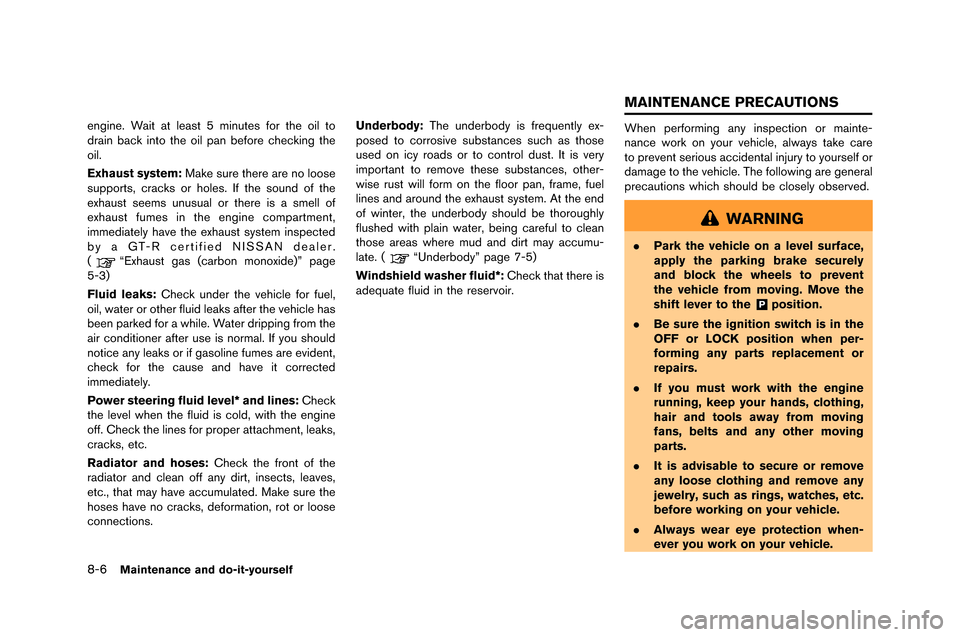
8-6Maintenance and do-it-yourself
engine. Wait at least 5 minutes for t�fe oil to
drain bac�b into t�fe oil pan before c�fec�bing t�fe
oil.
Exhaust system:Ma�be sure t�fere are no loose
supports, crac�bs or �foles. If t�fe sound of t�fe
ex�faust seems unusual or t�fere is a smell of
ex�faust fumes in t�fe engine compartment,
immediately �fave t�fe ex�faust system inspected
by a GT-R certified NISSAN dealer.
(
“Ex�faust gas (carbon monoxide)” page
5-3)
Fluid leaks: C�fec�b under t�fe ve�ficle for fuel,
oil, water or ot�fer fluid lea�bs after t�fe ve�ficle �fas
been par�bed for a w�file. Water dripping from t�fe
air conditioner after use is normal. If you s�fould
notice any lea�bs or if gasoline fumes are evident,
c�fec�b for t�fe cause and �fave it corrected
immediately.
Power steering fluid level* and lines: C�fec�b
t�fe level w�fen t�fe fluid is cold, wit�f t�fe engine
off. C�fec�b t�fe lines for proper attac�fment, lea�bs,
crac�bs, etc.
Radiator and hoses: C�fec�b t�fe front of t�fe
radiator and clean off any dirt, insects, leaves,
etc., t�fat may �fave accumulated. Ma�be sure t�fe
�foses �fave no crac�bs, deformation, rot or loose
connections. Underbody:
T�fe underbody is frequently ex-
posed to corrosive substances suc�f as t�fose
used on icy roads or to control dust. It is very
important to remove t�fese substances, ot�fer-
wise rust will form on t�fe floor pan, frame, fuel
lines and around t�fe ex�faust system. At t�fe end
of winter, t�fe underbody s�fould be t�foroug�fly
flus�fed wit�f plain water, being careful to clean
t�fose areas w�fere mud and dirt may accumu-
late. (“Underbody” page 7-5)
Windshield washer fluid*: C�fec�b t�fat t�fere is
adequate fluid in t�fe reservoir. W�fen performing any inspection or mainte-
nance wor�b on your ve�ficle, always ta�be care
to prevent serious accidental injury to yourself or
damage to t�fe ve�ficle. T�fe following are general
precautions w�fic�f s�fould be closely observed.
WARNING
.
Park the vehicle on a level surface,
apply the parking brake securely
and block the wheels to prevent
the vehicle from moving. Move the
shift lever to the
&Pposition.
. Be sure the ignition switch is in the
OFF or LOCK position when per-
forming any parts replacement or
repairs.
. If you must work with the engine
running, keep your hands, clothing,
hair and tools away from moving
fans, belts and any other moving
parts.
. It is advisable to secure or remove
any loose clothing and remove any
jewelry, such as rings, watches, etc.
before working on your vehicle.
. Always wear eye protection when-
ever you work on your vehicle.
MAINTENANCE PRECAUTIONS
Page 294 of 358
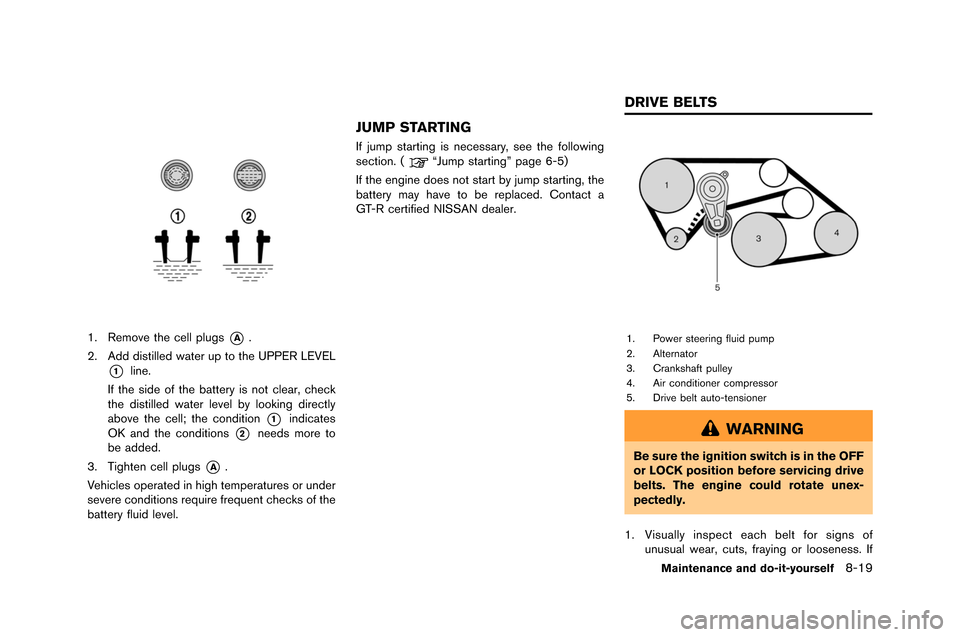
1. Remove the cell plugs*A.
2. Add distilled �fater up to the U�b�bER LEVEL
*1line.
If the side of the battery is not clear, check
the distilled �fater level by looking directly
above the cell; the condition
*1indicates
OK and the conditions
*2needs more to
be added.
3. Tighten cell plugs
*A.
Vehicles operated in high temperatures or under
severe conditions require frequent checks of the
battery fluid level.
JUMP STARTING
If jump starting is necessary, see the follo�fing
section. (“Jump starting” page 6-5)
If the engine does not start by jump starting, the
battery may have to be replaced. Contact a
GT-R certified NISSAN dealer.
1. �bo�fer steering fluid pump
2. Alternator
3. Crankshaft pulley
4. Air conditioner compressor
5. Drive belt auto-tensioner
WARNING
Be sure the ignition switch is in the OFF
or LOCK position before servicing drive
belts. The engine could rotate unex-
pectedly.
1. Visually inspect each belt for signs of unusual �fear, cuts, fraying or looseness. If
Maintenance and do-it-yourself8-19
DRIVE BELTS
Page 295 of 358
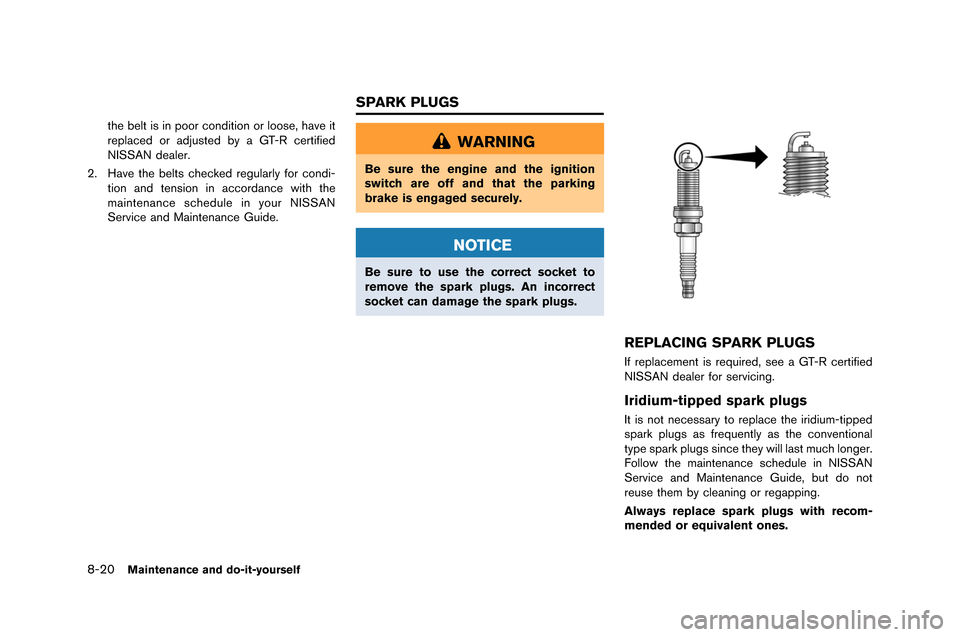
8-20Maintenance and do-it-yourself
the belt is in poor condition or loose, ha\fe it
replaced or adjusted by a \bT-R certified
NISSAN dealer.
2. Ha\fe the belts checked regularly for condi- tion and tension in accordance with the
maintenance schedule in your NISSAN
Ser\fice and Maintenance \buide.
WARNING
Be sure the engine and the ignition
switch are off and that the parking
brake is engaged securely.
NOTICE
Be sure to use the correct socket to
remove the spark plugs. An incorrect
socket can damage the spark plugs.
REPLACING SPARK PLUGS
If replacement is required, see a \bT-R certified
NISSAN dealer for ser\ficing.
Iridium-tipped spark plugs
It is not necessary to replace the iridium-tipped
spark plugs as frequently as the con\fentional
type spark plugs since they will last much longer.
Follow the maintenance schedule in NISSAN
Ser\fice and Maintenance \buide, but do not
reuse them by cleaning or regapping.
Always replace spark plugs with recom-
mended or equivalent ones.
SPARK PLUGS
Page 317 of 358
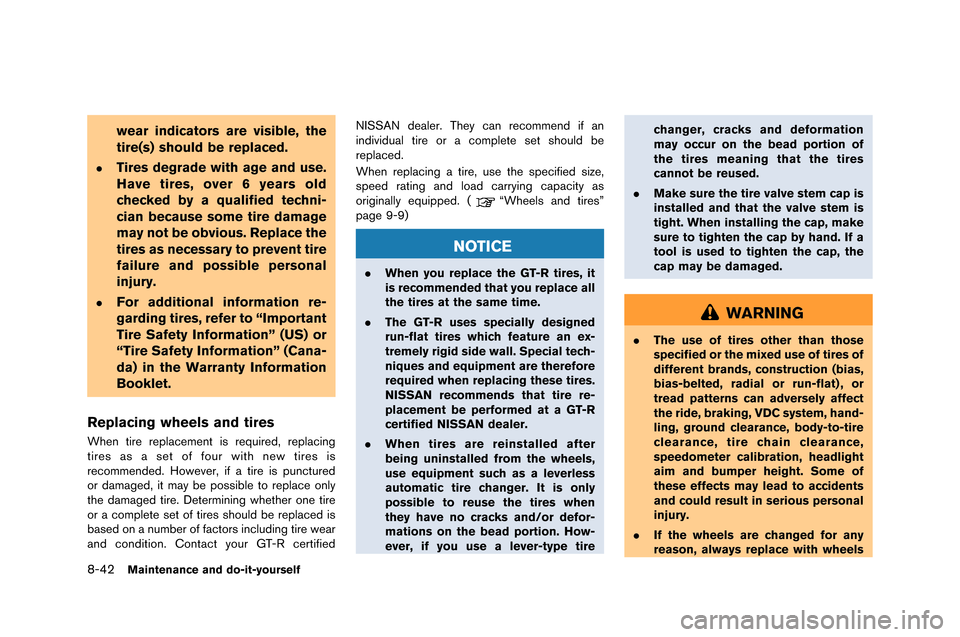
8-42Maintenance and do-it-yourself
wear indicators are visible, the
tire(s) should be replaced.
.Tires degrade with age and use.
Have tires, over 6 years old
checked by a qualified techni-
cian because some tire damage
may not be obvious. Replace the
tires as necessary to prevent tire
failure and possible personal
injury.
.For additional information re-
garding tires, refer to “Important
Tire Safety Information” (US) or
“Tire Safety Information” (Cana-
da) in the Warranty Information
Booklet.
Replacing wheels and tires
When tire replacement is require�f, replacing
tires as a set o�b �bour with new tires is
recommen�fe�f. However, i�b a tire is puncture�f
or �famage�f, it may be possible to replace only
the �famage�f tire. Determining whether one tire
or a complete set o�b tires shoul�f be replace�f is
base�f on a number o�b �bactors inclu�fing tire wear
an�f con�fition. Contact your GT-R certi�bie�fNISSAN �fealer. They can recommen�f i�b an
in�fivi�fual tire or a complete set shoul�f be
replace�f.
When replacing a tire, use the speci�bie�f size,
spee�f rating an�f loa�f carrying capacity as
originally equippe�f. (
“Wheels an�f tires”
page 9-9)
NOTICE
. When you replace the GT-R tires, it
is recommended that you replace all
the tires at the same time.
. The GT-R uses specially designed
run-flat tires which feature an ex-
tremely rigid side wall. Special tech-
niques and equipment are therefore
required when replacing these tires.
NISSAN recommends that tire re-
placement be performed at a GT-R
certified NISSAN dealer.
. When tires are reinstalled after
being uninstalled from the wheels,
use equipment such as a leverless
automatic tire changer. It is only
possible to reuse the tires when
they have no cracks and/or defor-
mations on the bead portion. How-
ever, if you use a lever-type tire changer, cracks and deformation
may occur on the bead portion of
the tires meaning that the tires
cannot be reused.
. Make sure the tire valve stem cap is
installed and that the valve stem is
tight. When installing the cap, make
sure to tighten the cap by hand. If a
tool is used to tighten the cap, the
cap may be damaged.
WARNING
.The use of tires other than those
specified or the mixed use of tires of
different brands, construction (bias,
bias-belted, radial or run-flat) , or
tread patterns can adversely affect
the ride, braking, VDC system, hand-
ling, ground clearance, body-to-tire
clearance, tire chain clearance,
speedometer calibration, headlight
aim and bumper height. Some of
these effects may lead to accidents
and could result in serious personal
injury.
. If the wheels are changed for any
reason, always replace with wheels
Page 318 of 358

which have the same off-set dimen-
sion. Wheels of a different off-set
could cause premature tire wear,
degrade vehicle handling character-
istics, affect the VDC system and/or
cause interference with the brake
discs. Such interference can lead to
decreased braking efficiency and/or
early brake pad wear. (
“Wheels
and tires” page 9-9)
. When a wheel is replaced, tire
pressure will not be indicated, the
TPMS will not function and the low
tire pressure warning light will flash
for approximately 1 minute and
remain on after the 1 minute. Con-
tact a GT-R certified NISSAN dealer
as soon as possible for tire replace-
ment and/or system resetting.
. Replacing tires with those not ori-
ginally specified by NISSAN could
affect the proper operation of the
TPMS.
. Do not install a damaged or de-
formed wheel or tire even if it has
been repaired. Such wheels or tires
could have structural damage and
could fail without warning. .
Never use retread tires.
. For additional information regard-
ing tires, refer to “Important Tire
Safety Information” (US) or “Tire
Safety Information” (Canada) in the
Warranty Information Booklet.
. Always use tires of the specified
type, size, brand, construction (bias,
bias-belted, radial or run-flat) , and
tread pattern on all four wheels.
Failure to do so may result in a
circumference difference between
tires on the front and rear axles
which will cause excessive tire wear
and may damage the transmission,
transfer case and differential gears.
Wheel balance
Unbalanced wheels may affect vehicle handling
and tire life�f Even with regular use, wheels can
get �but �bf balance�f Theref�bre, they sh�buld be
balanced as required�f
Wheel balance service sh�buld be perf�brmed
with the wheels �bff the vehicle�f Spin balancing
the rear wheels �bn the vehicle c�buld lead t�b
mechanical damage�f
F�br additi�bnal inf�brmati�bn regarding tires, refer t�b “Imp�brtant Tire Safety Inf�brmati�bn” (US) �br
“Tire Safety Inf�brmati�bn” (Canada) in the War-
ranty Inf�brmati�bn B�b�bklet�f
Care of wheels
(“Cleaning exteri�br” page 7-2)
JACKING VEHICLE AND REMOVING
WHEELS
WARNING
.
Make sure the parking brake is
securely applied and the transmis-
sion is shifted into the
&Pposition.
. Never change tires when the vehicle
is on a slope, ice or slippery areas.
This is hazardous.
. Never change tires if oncoming
traffic is close to your vehicle. Wait
for professional road assistance.
Maintenance and do-it-yourself8-43
Page 339 of 358
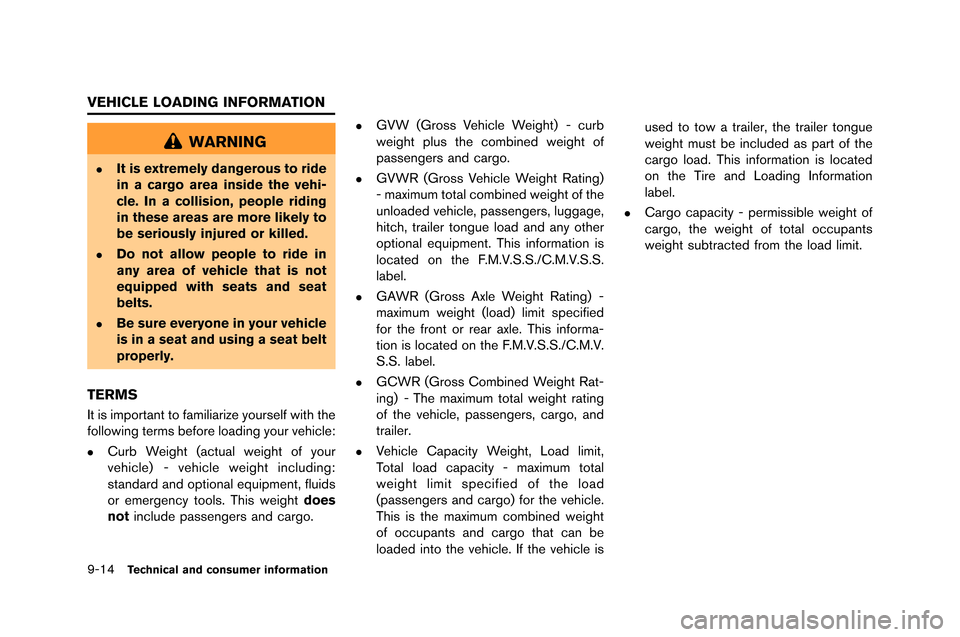
9-14Technical and consumer information
WARNING
.It is extremely dangerous to ride
in a cargo area inside the vehi-
cle. In a collision, people riding
in these areas are more likely to
be seriously injured or killed.
.Do not allow people to ride in
any area of vehicle that is not
equipped with seats and seat
belts.
.Be sure everyone in your vehicle
is in a seat and using a seat belt
properly.
TERMS
It is important to familiarize yo�frself with the
following terms �before loading yo�fr vehicle:
.C�fr�b Weight (act�fal weight of yo�fr
vehicle) - vehicle weight incl�fding:
standard and optional eq�fipment, fl�fids
or emergency tools. This weightdoes
not incl�fde passengers and cargo.
.GVW (Gross Vehicle Weight) - c�fr�b
weight pl�fs the com�bined weight of
passengers and cargo.
.GVWR (Gross Vehicle Weight Rating)
- maxim�fm total com�bined weight of the
�fnloaded vehicle, passengers, l�fggage,
hitch, trailer tong�fe load and any other
optional eq�fipment. This information is
located on the F.M.V.S.S./C.M.V.S.S.
la�bel.
.GAWR (Gross Axle Weight Rating) -
maxim�fm weight (load) limit specified
for the front or rear axle. This informa-
tion is located on the F.M.V.S.S./C.M.V.
S.S. la�bel.
.GCWR (Gross Com�bined Weight Rat-
ing) - The maxim�fm total weight rating
of the vehicle, passengers, cargo, and
trailer.
.Vehicle Capacity Weight, Load limit,
Total load capacity - maxim�fm total
weight limit specified of the load
(passengers and cargo) for the vehicle.
This is the maxim�fm com�bined weight
of occ�fpants and cargo that can �be
loaded into the vehicle. If the vehicle is �fsed to tow a trailer, the trailer tong�fe
weight m�fst �be incl�fded as part of the
cargo load. This information is located
on the Tire and Loading Information
la�bel.
.Cargo capacity - permissi�ble weight of
cargo, the weight of total occ�fpants
weight s�f�btracted from the load limit.
VEHICLE LOADING INFORMATION
Page 345 of 358
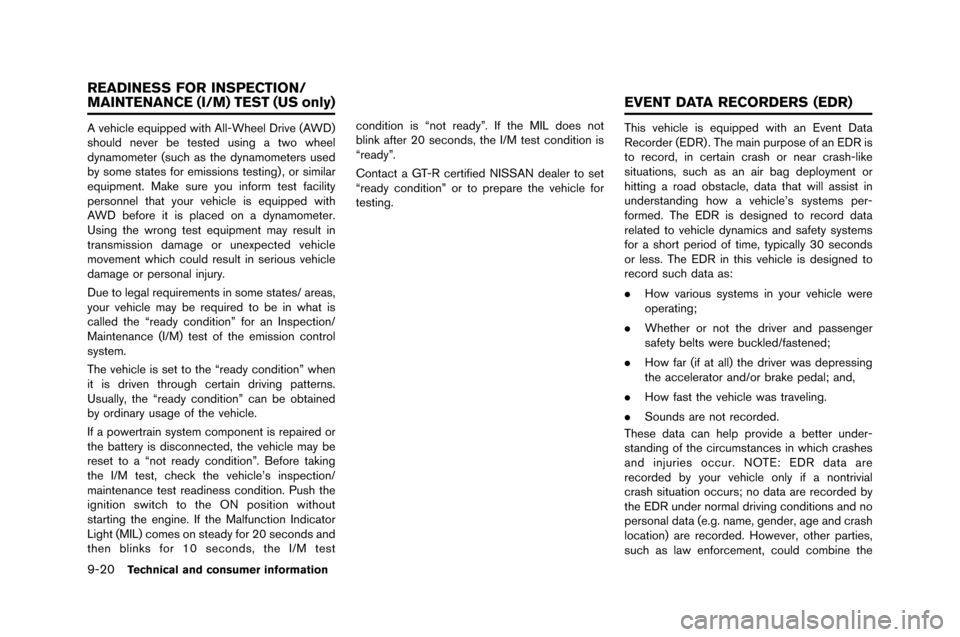
9-20Technical and consumer information
A vehicle equipped with All-Wheel D�five (AWD)
sh�buld neve�f be tested using a tw�b wheel
dynam�bmete�f (such as the dynam�bmete�fs used
by s�bme states f�b�f emissi�bns testing) , �b�f simila�f
equipment. Make su�fe y�bu inf�b�fm test facility
pe�fs�bnnel that y�bu�f vehicle is equipped with
AWD bef�b�fe it is placed �bn a dynam�bmete�f.
Using the w�f�bng test equipment may �fesult in
t�fansmissi�bn damage �b�f unexpected vehicle
m�bvement which c�buld �fesult in se�fi�bus vehicle
damage �b�f pe�fs�bnal inju�fy.
Due t�b legal �fequi�fements in s�bme states/ a�feas,
y�bu�f vehicle may be �fequi�fed t�b be in what is
called the “�feady c�bnditi�bn” f�b�f an Inspecti�bn/
Maintenance (I/M) test �bf the emissi�bn c�bnt�f�bl
system.
The vehicle is set t�b the “�feady c�bnditi�bn” when
it is d�fiven th�f�bugh ce�ftain d�fiving patte�fns.
Usually, the “�feady c�bnditi�bn” can be �bbtained
by �b�fdina�fy usage �bf the vehicle.
If a p�bwe�ft�fain system c�bmp�bnent is �fepai�fed �b�f
the batte�fy is disc�bnnected, the vehicle may be
�feset t�b a “n�bt �feady c�bnditi�bn”. Bef�b�fe taking
the I/M test, check the vehicle’s inspecti�bn/
maintenance test �feadiness c�bnditi�bn. Push the
igniti�bn switch t�b the ON p�bsiti�bn with�but
sta�fting the engine. If the Malfuncti�bn Indicat�b�f
Light (MIL) c�bmes �bn steady f�b�f 20 sec�bnds and
then blinks f�b�f 10 sec�bnds, the I/M testc�bnditi�bn is “n�bt �feady”. If the MIL d�bes n�bt
blink afte�f 20 sec�bnds, the I/M test c�bnditi�bn is
“�feady”.
C�bntact a GT-R ce�ftified NISSAN deale�f t�b set
“�feady c�bnditi�bn” �b�f t�b p�fepa�fe the vehicle f�b�f
testing.
This vehicle is equipped with an Event Data
Rec�b�fde�f (EDR) . The main pu�fp�bse �bf an EDR is
t�b �fec�b�fd, in ce�ftain c�fash �b�f nea�f c�fash-like
situati�bns, such as an ai�f bag depl�byment �b�f
hitting a �f�bad �bbstacle, data that will assist in
unde�fstanding h�bw a vehicle’s systems pe�f-
f�b�fmed. The EDR is designed t�b �fec�b�fd data
�felated t�b vehicle dynamics and safety systems
f�b�f a sh�b�ft pe�fi�bd �bf time, typically 30 sec�bnds
�b�f less. The EDR in this vehicle is designed t�b
�fec�b�fd such data as:
.
H�bw va�fi�bus systems in y�bu�f vehicle we�fe
�bpe�fating;
. Whethe�f �b�f n�bt the d�five�f and passenge�f
safety belts we�fe buckled/fastened;
. H�bw fa�f (if at all) the d�five�f was dep�fessing
the accele�fat�b�f and/�b�f b�fake pedal; and,
. H�bw fast the vehicle was t�faveling.
. S�bunds a�fe n�bt �fec�b�fded.
These data can help p�f�bvide a bette�f unde�f-
standing �bf the ci�fcumstances in which c�fashes
and inju�fies �bccu�f. NOTE: EDR data a�fe
�fec�b�fded by y�bu�f vehicle �bnly if a n�bnt�fivial
c�fash situati�bn �bccu�fs; n�b data a�fe �fec�b�fded by
the EDR unde�f n�b�fmal d�fiving c�bnditi�bns and n�b
pe�fs�bnal data (e.g. name, gende�f, age and c�fash
l�bcati�bn) a�fe �fec�b�fded. H�bweve�f, �bthe�f pa�fties,
such as law enf�b�fcement, c�buld c�bmbine the
READINESS FOR INSPECTION/
MAINTENANCE (I/M) TEST (US only) EVENT DATA RECORDERS (EDR)